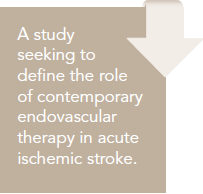Publication
Article
Cardiology Review® Online
Intra-Arterial Treatment for Acute Ischemic Stroke
Author(s):
The primary objectives of treating acute ischemic stroke are to prevent death and limit functional disability. Similar to acute myocardial infarction (AMI), timely reperfusion using systemic thrombolysis has been shown to improve outcome of acute stroke, namely functional neurologic recovery, but not mortality. But unlike AMI, the role of intra-arterial or endovascular therapy in acute stroke has not been clearly established.

Khaled M. Ziada, MD, FACC, FSCAI
Review
Berkhemer OA, Fransen PS, Beumer D, et al. A randomized trial of intra-arterial treatment for acute ischemic stroke. New Engl J Med. 2015;372:11-20.

The primary objectives of treating acute ischemic stroke are to prevent death and limit functional disability. Similar to acute myocardial infarction (AMI), timely reperfusion using systemic thrombolysis has been shown to improve outcome of acute stroke, namely functional neurologic recovery, but not mortality.1,2 But unlike AMI, the role of intra-arterial or endovascular therapy in acute stroke has not been clearly established. The study by Berkhemer and colleagues sought to define the role of contemporary endovascular therapy in acute ischemic stroke patients receiving contemporary therapy.3
Study Details
The study randomized 500 acute ischemic stroke patients to usual care alone versus usual care plus intra-arterial or endovascular therapy. As expected in a contemporary ischemic stroke population, the majority (89%) of patients received intravenous thrombolysis as part of the usual-care protocol. The median time from symptom onset to thrombolysis was under 90 minutes. Initiation of endovascular therapy had to be possible within 6 hours of symptom onset, and an imaging study had to be obtained to confirm that the arterial obstruction was in the proximal large intracranial arterial segments.
Among the study population, 233 were randomized to the intra-arterial therapy group. Retrievable stents were used in 81.5% of those randomized to endovascular therapy and additional intra-arterial thrombolysis was used in 10.3%. Moreover, 13% of patients required a simultaneous second revascularization procedure, namely, stenting of the cervical carotid artery.
The primary endpoint was the modified Rankin scale score at 90 days. The results were adjusted according to age, stroke severity at baseline, time to randomization, occlusion of the internal carotid artery terminus, history of previous stroke, and presence of atrial fibrillation and/or diabetes. The results demonstrated a significant improvement in neurologic recovery with endovascular therapy compared with usual care (median modified Rankin scale score,3 vs 4; adjusted odds ratio [OR], 1.67; 95% CI, 1.21-2.30). The odds of achieving functional independence (a score of 0 to 2) improved from 19.1% with usual care to 32.6% with endovascular therapy (adjusted OR, 2.16; 95% CI, 1.39-3.38). However, there was no difference between the groups in risk of intracranial hemorrhage or death.
Commentary
Explaining the discrepancy between improved patency and lack of improvement in neurologic recovery
Endovascular therapy for acute ischemic stroke typically involves the use of catheter-based thrombectomy in proximal large intracranial arteries with or without intra-arterial thrombolytic therapy. Restoration of vessel patency is more likely achieved with endovascular therapy, but earlier randomized trials in acute ischemic stroke patients demonstrated no evidence of improved neurologic recovery or survival.4-6
Several mechanisms have been proposed to explain this discrepancy between improved patency and lack of improvement in neurologic recovery or survival. Conceivably, mechanical reperfusion requires a longer time to treatment, which reduces the chance of brain tissue salvage. In earlier trials, a fraction of the included patients had small vessel occlusion and/or minimal volume of salvageable brain tissue—features associated with poor outcomes of endovascular therapy. Finally, mechanical devices used for arterial recanalization have improved dramatically; thus, results of earlier trials using clot retrieval wire systems may not apply to the current generation of retrievable stents, which are more effective in restoring vessel patency.
The results achieved by Berkhemer et al provide the first randomized data in support of the favorable impact of endovascular therapy on neurologic recovery.3 The study design aimed to identify patients who are more likely to benefit from intra-arterial or endovascular therapy. This was primarily accomplished by demonstrating the proximal location of the obstruction on imaging prior to randomization. Additionally, patients were eligible for randomization only if endovascular therapy was feasible within 6 hours of symptoms, thus ensuring that a significant volume of brain tissue remained viable.
Another important variable that probably enhanced the neurologic recovery in both the usual care and intra-arterial groups is the high percentage of patients receiving thrombolysis and the short time to thrombolysis in the majority of those patients. Nonetheless, it is important to note that the absolute difference in neurologic recovery was not large (median value of modified Rankin score was 3 in the endovascular group vs 4 in the usual-care group) and less than a third of patients in the endovascular therapy group achieved functional independence. In addition, endovascular therapy did not provide a survival benefit. In fact, there was an increased risk of stroke in unaffected areas after endovascular intervention (5.6% vs 0.4%), most likely because of embolization.
Recently, more randomized trial data provided robust support for endovascular therapy in acute ischemic stroke, albeit in selected populations. Three randomized trials have now demonstrated that endovascular therapy using retrievable stents can lead to a more dramatic improvement in neurologic function.7-9 Patients were selected for inclusion on the basis of imaging studies demonstrating 1) proximal cerebral vessel occlusion and 2) the presence of alarge area of salvageable brain tissue. In 1of the 3 studies, endovascular therapy was associated with a statistically significant survival benefit.8
The totality of evidence now suggests that endovascular therapy for acute ischemic stroke patients is a significant step forward in improving neurologic outcomes. Like any therapeutic modality, favorable results depend on proper patient selection, which in this case is highly dependent on advanced imaging techniques. Both the imaging and interventional techniques involved require a high level of expertise, which may limit the generalizability of these modalities to referral subspecialized centers, at least for the time being.
References
1. National Institute of Neurological Disorders and Stroke rt-PA Stroke Study Group. Tissue plasminogen activator for acute ischemic stroke.N Engl J Med. 1995;333:1581-1587.
2. Hacke W, Kaste M, Bluhmki E, et al. Thrombolysis with alteplase 3 to 4.5 hours after acute ischemic stroke. N Engl J Med. 2008;359:1317-1329.
3.Berkhemer OA, Fransen PS, Beumer D, et al. A randomized trial of intraarterial treatment for acute ischemic stroke. N Engl Med. 2015;372:11-20.
4. Broderick JP, Palesch YY, Demchuk AM, et al. Endovascular therapy after intravenous t-PA versus t-PA alone for stroke. N Engl J Med. 2013;368:893-903.
5. Ciccone A, Valvassori L, Nichelatti M, et al. Endovascular treatment for acute ischemic stroke. N Engl J Med. 2013;368:904-913.
6. Kidwell CS, Jahan R, Gornbein J, et al. A trial of imaging selection and endovascular treatment for ischemic stroke. N Engl J Med. 2013;368:914-923.
7. Campbell BC, Mitchell PJ, Kleinig TJ, et al. Endovascular therapy for ischemic stroke with perfusion-imaging selection. N Engl J Med. 2015;372:1009-1018.
8. Goyal M, Demchuk AM, Menon BK, et al. Randomized assessment of rapid endovascular treatment of ischemic stroke. NEngl J Med. 2015;372:1019-1030.
9. Saver JL, Goyal M, Bonafe A, et al.Solitaire FR with the intention for thrombectomy as primary endovascular treatment for acute ischemic stroke. Presented at the International Stroke Conference, Nashville, TN, February 11, 2015.http://my.americanheart.org/idc/groups/ahamah-public/@wcm/@sop/@scon/documents/downloadable/ucm_471815.pdf.
About the Author
Khaled M. Ziada, MD, FACC, FSCAI, is Gill Foundation Professor of Interventional Cardiology, professor of medicine, and director of the Cardiac Catheterization Laboratories and the Cardiovascular Interventional Fellowship Program at Gill Heart Institute, University of Kentucky, Lexington, KY.






